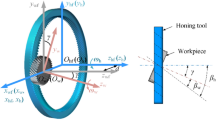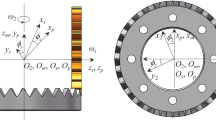Abstract
As the necessary conditions, high precision and good mechanical performance gear is very important for a high speed and precision transmission system. To meet the requirement of the performance, gear finishing processes including gear honing and gear grinding have been mainly adopted. To compare the tooth surface of these two gear finishing processes, this paper gives the formation mechanism of gear tooth surface texture and conducts some comparative experiments on the gear surface texture and residual stress. Based on the spatial engagement principle and the discrete points of work-piece gear tooth spiral involute surface, the tooth surface contact area models of gears from the two processes are built, respectively, and the prediction models of honing paths and grinding paths are generated according to the velocity vector of the sampling points on tooth surface. Then the contrast and verification tests of the prediction models are carried out on internal gearing power honing machine and worm wheel gear grinding machine, respectively. Results indicate that the predicted curve shape honing paths and the longitudinal linear shape grinding paths of tooth surface are both similar to the experiment ones, respectively. Furthermore, some detailed quantitative analyses of tooth surface qualities including surface texture and tooth surface residual stress has been finished. It is found that the surface roughness value of gear grinding work-piece gear tooth surface is lower than that of gear honing process and the distribution of compressive residual stress on gear tooth surface is associated with the principles and parameters of the two processes. This research has theoretical and instructional significance for the improvement of gear honing and grinding processes.

















Similar content being viewed by others
Abbreviations
- (H) and (G):
-
Gear honing and gear grinding
- r b1 :
-
The base circle radius of work-piece gear
- λ 1 :
-
The generating angle of involute at the contact point
- v O1 :
-
The velocity vector of the contact point on the tooth surface of work-piece gear
- v O2 :
-
The velocity vector of the contact point on the tooth surface of honing wheel or grinding wheel
- v 12 :
-
The relative velocity vector of a random contact point in coordinate system S(O − x − y − z)
- n :
-
The tooth surface normal vector in coordinate system S(O − x − y − z)
- r O1 :
-
The position vector of contact points on work-piece gear tooth surface in coordinate system S(O − x − y − z)
- r O2 :
-
The position vector of contact points on honing wheel tooth surface in coordinate system S(O − x − y − z)
- r 1 :
-
The position vector of contact points on work-piece gear tooth surface in coordinate system S1(O 1 − x 1 − y 1 − z 1)
- β :
-
The helix angle of work-piece gear
- m n :
-
The module of work-piece gear
- v z :
-
The feed velocity of Z 1 axis
- β :
-
The helix angle of work-piece gear
- m n :
-
The module of work-piece gear
- Σ:
-
The crossed axis angle between work-piece gear and honing wheel or grinding wheel
- N 1 :
-
The tooth number of work-piece gear and grinding wheel
- N 2 :
-
The tooth number of grinding wheel
- φ 1 :
-
The rotation angle of work-piece gear
- φ 2 :
-
The rotation angle of honing wheel or grinding wheel
- w O1 :
-
The angular velocity vector of work-piece gear in coordinate system S(O − x − y − z)
- w O2 :
-
The angular velocity vector of honing wheel in coordinate system S(O − x − y − z)
- M OP :
-
The coordinate transmission matrix from Sp(O p − x p − y p − z p) to S(O − x − y − z)
- M O1 :
-
The coordinate transmission matrix from S1(O 1 − x 1 − y 1 − z 1) to S(O − x − y − z)
- r O1 :
-
The position vector of contact points on work-piece gear tooth surface in coordinate system S(O − x − y − z)
- r O2 :
-
The position vector of contact points on honing wheel or grinding wheel tooth surface in coordinate system S(O − x − y − z)
References
Karpuschewski B, Knoche HJ, Hipke M (2008) Gear finishing by abrasive processes [J]. CIRP Ann Manuf Technol 57(2):621–640
Brinksmeier E, Giwerzew A (2005) Hard gear finishing viewed as a process of abrasive wear[J]. Wear 258(1–4):62–69
Liu Y, Wang X, Lin J et al (2015) Early chatter detection in gear grinding process using servo feed motor current [J]. Int J Adv Manuf Technol 83(9–12):1–10
Klocke F, BrummM, Kampka M (2014) Process model for honing larger gears [C]. In: International gear conference, pp 119–128
Klocke F, Brumm M, Reimann J (2013) Development and validation of a cutting force model for generating gear grinding [J]. Forsch Ing Eng Res 77(3–4):81–94
Ling S, Zhang B, Zhang J et al (2014) Two gear-grinding techniques to improve pitch deviations of ultra-precision gears[J]. Proc Inst Mech Eng Part B J Eng Manuf 229(11):1–8
Wang Huiliang, Li Jubo, Gao Yang (2015) Closed-loop feedback flank errors correction of topographic modification of helical gears based on form grinding [J]. Math Prob Eng 2015:1–11
Ding H, Tang J, Zhong J (2016) Accurate nonlinear modeling and computing of grinding machine settings modification considering spatial geometric errors for hypoid gears[J]. Mech Mach Theory 99:155–175
Denkena B, Schindler A, Woiwode S (2016) Calculation method of the contact area in flank machining for continuous generating grinding[J]. Appl Math Model 40(15–16):7138–7146
Denkena B, Köhler J, Schindler A et al (2014) Continuous generating grinding—material engagement in gear tooth root machining[J]. Mech Mach Theory 81(11):11–20
Jolivet S, Mezghani S, Mansori ME et al (2014) Numerical simulation of tooth surface finish effects on gear noise[C]. In: ASME 2014, Biennial conference on engineering systems design and analysis, V001T04A007–V001T04A007
Jolivet S, Mezghani S, Mansori ME et al (2015) Dependence of tooth flank finishing on powertrain gear noise[J]. J Manuf Syst 42:467–471
Chen H, Tang J, Zhou W (2013) Modeling and predicting of surface roughness for generating grinding gear[J]. J Mater Process Technol 213(5):717–721
Wang YZ, Chen YY, Zhou GM et al (2016) Roughness model for tooth surfaces of spiral bevel gears under grinding[J]. Mech Mach Theory 104:17–30
Chiang CJ, Fong ZH, Chang KL (2009) Computerized gear cutting simulation using a pseudo-planar method[J]. Proc Inst Mech Eng Part B J Eng Manuf 223(12):1541–1551
Dietz C, Wegener K, Thyssen W (2016) Continuous generating grinding: machine tool optimisation by coupled manufacturing simulation[J]. J Manuf Process 23:211–221
Köhler J, Schindler A, Woiwode S (2012) Continuous generating grinding—tooth root machining and use of CBN-tools[J]. CIRP Ann Manuf Technol 61(1):291–294
Zwolak J, Palczak A (2016) Effect of gear teeth finishing method on properties of teeth surface layer and its resistance to pitting wear creation[J]. J Cent South Univ 23(1):68–76
Qinxue Pan, Shuai Liu, Dingguo Xiao (2015) The method of gear residual stress measurement based on ultrasonic technology [J]. Acta Armamentarii 36(9):1757–1765
Mallipeddi D, Norell M, Nyborg L (2015) Stress distribution over gear teeth after grinding, running-in and efficiency testing[C]. In: International conference on gears, VDI-Berichte 2255.2. 2015, 2, pp 973–984
Sorsa A, Leiviskä K, Santa-Aho S et al (2013) An efficient procedure for identifying the prediction model between residual stress and Barkhausen noise[J]. J Nondestr Eval 32(4):341–349
Fergani O, Shao Y, Lazoglu I et al (2014) Temperature effects on grinding residual stress [J]. Proc Cirp 14:2–6
Nakatsuka N, Hirai Y, Kusakabe A et al (2014) Effect of coolant supplied through grinding wheel on residual stress of grinding surface[J]. Adv Mater Res 1017:33–37
Nélias D, Boucly V (2008) Prediction of grinding residual stresses[J]. Int J Mater Form 1(1):1115–1118
Tönissen S, Klocke F, Feldhaus B et al (2012) Residual stress prediction in quick point grinding[J]. Prod Eng Res Devel 6(3):243–249
Acknowledgements
The authors would like to thank the National Natural Science Foundation of China (51575154) and National Science and Technology Major Project (2013ZX04002051) for supporting this research under Grant.
Author information
Authors and Affiliations
Corresponding author
Additional information
Technical Editor: Márcio Bacci da Silva.
Rights and permissions
About this article
Cite this article
Han, J., Yuan, B., Wang, D. et al. Formation mechanism study on tooth surface of two gear finishing processes: combined theoretical and experimental approaches. J Braz. Soc. Mech. Sci. Eng. 39, 5159–5170 (2017). https://doi.org/10.1007/s40430-017-0872-z
Received:
Accepted:
Published:
Issue Date:
DOI: https://doi.org/10.1007/s40430-017-0872-z




